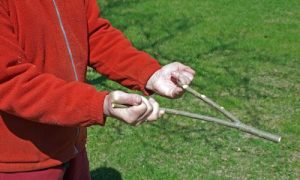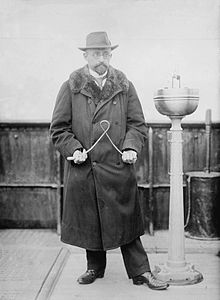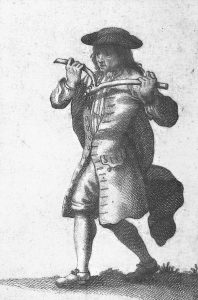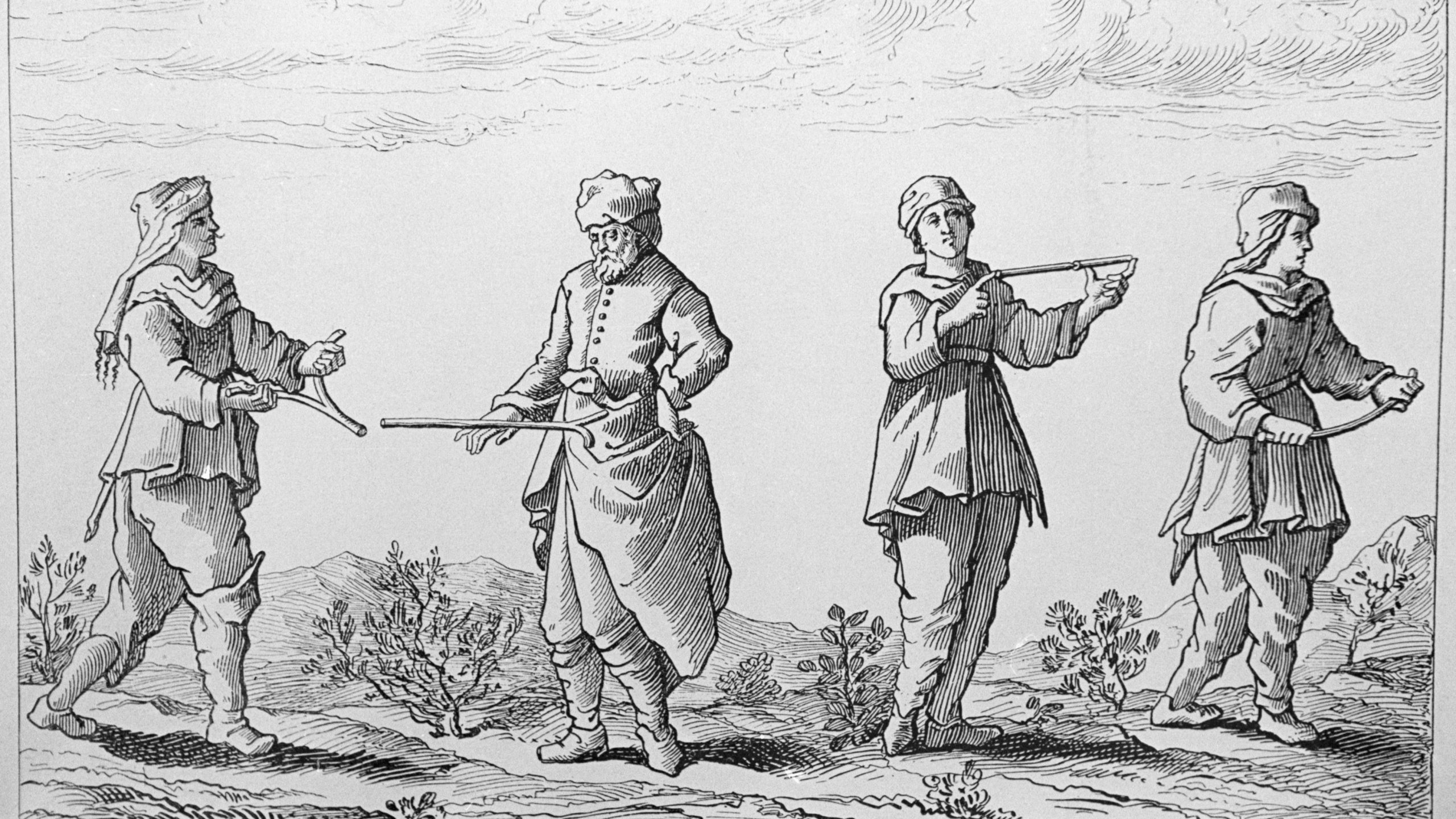

Lets start off with a successful accurate location using dowsing rods.
Yes, Dowsing works, If your a magician like Darren Brown. If you listen carefully, He directed the man using specific words. This is essentially a magic trick. He uses a magicians trick called NLP, to direct the dowser in the direction of the film canister with water.
In this post there are more examples of dowsing and the science behind it.
Some scientists believe that we had a good sense of the magnetic fields a long time ago and lost the ability due to evolution.
So, Can Humans Sense Magnetic Fields?
Yes, The human brain can pick up stimulus of the the earths magnetic field. But we cannot use the human brain alone, for any accurate location of utilities or underground water sources.
In the intricate world of utility locating, where precision is paramount and the stakes are high, the age-old practice of dowsing, witching, or divining rods has resurfaced as a method some claim to be effective in locating underground utilities.
However, before delving into ancient practices, it's crucial to understand the modern procedures and the scientific stance on these methods.
The Importance of Accurate Utility Locating
Before installing an underground fibre optic network—or any utility, for that matter—professionals rely on services like the Dial before you dig website and 1100 hotline in Australia.
This service provides geographic information data detailing the location of all underground utilities.
However, not all areas have maintained records of their underground utilities, leading some to consider alternative methods like dowsing rods.


Dowsing Rods: A Brief Overview
Dowsing rods, traditionally Y-shaped branches or L-shaped rods, are claimed by some to locate water, pipelines, gas lines, and other subsurface objects.
The theory goes that when the rods cross or tug, they indicate the presence of the desired object below.
Yet, this method is mired in controversy, largely because its efficacy is no better than chance.
The Science Behind Dowsing Rods
Research categorizes dowsing alongside pseudoscience, attributing any perceived success to the ideomotor effect—unconscious movements that occur without the dowser realizing it.
This effect, similar to how an Ouija board works, suggests that the dowsing rods are simply amplifying slight, involuntary movements of the hands, not detecting underground utilities.
Despite some anecdotal claims of success, the lack of consistent scientific evidence undermines the credibility of dowsing rods for utility locating.
The risks involved with relying on such a method can be severe, including potential injury from undetected underground cables or pipes.
Professional Standards in Utility Locating
Utility locating is a field that demands precision, expertise, and the use of scientifically validated tools.
Professionals in this field undergo extensive training on how to use locating devices according to manufacturer instructions, ensuring safety and accuracy.
Dowsing, with its unreliable results and lack of scientific backing, falls short of these standards.
The Conclusion: Stick to Science
The fascination with dowsing rods as a utility locating method persists, driven by tales of success and the allure of an easy solution.
However, these narratives cannot supplant the rigorous requirements of safe and effective utility locating practices.
The potential dangers of dowsing—ranging from property damage to severe injury—underscore the necessity of relying on proven, scientific methods and technologies in utility locating.

There are many different ways to hold a divining rod or dowsing rod. Some people prefer to "witch" for water with a pendulum. The practice relies on the idea that the object will suddenly move when a person passes over water.
A Call to Rationality and Safety
For utility locators and anyone involved in underground work, the message is clear: prioritize safety, accuracy, and scientific integrity.
While exploring historical and unconventional methods can be intriguing, the responsibility to protect both people and infrastructure demands adherence to established, reliable practices.
Dowsing, witching, and divining rods, despite their long history and occasional anecdotal success, definitively do not meet the criteria for safe and effective utility locating.
As professionals and stewards of public safety, our duty is to employ the best tools and methods available—those grounded in science and proven through rigorous testing.
Informed Decisions for a Safer Future
The debate over dowsing rods serves as a reminder of the importance of critical thinking and evidence-based practices.
In utility locating, as in all technical fields, the well-being of individuals and the community must take precedence over unverified techniques.
By choosing scientifically validated methods, we ensure not only the success of our projects but also the safety of our workers and the public.
In conclusion, while dowsing rods may hold a place in historical and cultural discussions, their role in modern utility locating should be relegated to that of curiosity, not practice.
Let us move forward with the tools and knowledge that guarantee the highest standards of safety and efficacy.
Do Your Own Research
For those still curious or unconvinced, I encourage further research into the scientific studies and evidence surrounding dowsing and utility locating. Understanding the reality we live in, questioning our answers, and discussing our findings not only deepen our knowledge but also refine our approach to the challenges we face.
We emphasize the importance of relying on professional utility locators and scientifically validated methods. The journey from skepticism to knowledge is a path well worth taking, offering insights into the limitations and potentials of both traditional and modern practices in our quest to safely navigate the world beneath our feet.
FAQ: Unraveling the Mysteries of Dowsing Rods
What Are the Best Mythbusters Episodes on Divining Rods?
Mythbusters have tackled the subject of divining rods in several episodes, aiming to test the claims that these rods can locate water or metals underground. The consensus from these experiments is that dowsing is no more effective than random chance. These episodes are a must-watch for anyone curious about the scientific scrutiny applied to dowsing practices.
Can You Explain the Theory Behind Divining Rods?
The theory behind divining rods, also known as dowsing, suggests that these rods can detect underground water, metals, or other substances through the movement influenced by unseen forces. Critics argue that such movements are more likely caused by the ideomotor effect, where individuals make motions unconsciously.
Is There a Spiritual Component to Dowsing?
Some practitioners of dowsing believe there is a spiritual or mystical aspect to their ability, suggesting that the rods act as a medium for intuitive or psychic energies.
This perspective is not supported by scientific evidence, but it remains a significant part of why some people are drawn to dowsing.
How Do Dowsing Rods Indicate the Presence of Water?
Dowsing rods are said to move (either by crossing, dipping, or twitching) in response to the presence of underground water. Users claim that this movement is a direct indication of water beneath the surface, though scientific experiments have not found evidence to support this claim.
Are Dowsing Rods Magnetic, and Does This Affect Their Use?
Dowsing rods, traditionally made from materials like wood or metal, are not inherently magnetic. Some modern interpretations suggest that metal rods could be influenced by magnetic fields, but there is no conclusive evidence that this plays a role in the supposed detection of underground resources.
What Techniques Are Used in Water Dowsing?
Water dowsing techniques vary, but they typically involve holding the rods loosely in one's hands and walking over an area where water is suspected to be underground. The dowser looks for a reaction in the rods, such as crossing or dipping, to indicate the location of water.
How Can One Use Dowsing Rods Effectively?
To use dowsing rods, hold them in a relaxed grip and walk slowly over the area you wish to explore. The key is to be open and attentive to any movements of the rods, though it's essential to approach this practice with a critical mind, considering the lack of scientific backing.
Which Dowsing Rods Are Best for Finding Water in Australia?
In Australia, as elsewhere, there is no scientifically proven best dowsing rod for finding water. However, enthusiasts often prefer rods made from materials like copper for their supposed sensitivity to underground water.
How Can I Make My Own Dowsing Rods for Water Detection?
DIY dowsing rods can be made from wire coat hangers or similar materials. Cut the material to form two L-shaped rods, holding one in each hand by the short arm, with the long arms parallel to the ground. While simple to make, their effectiveness remains scientifically unproven.
Are There Any Reliable Dowsing Rods for Sale?
While various dowsing rods are available for purchase, ranging from simple copper rods to more elaborate designs, their reliability for finding water or any underground resources is not supported by scientific evidence.
What Should I Look for in Reviews of Dowsing, Witching, and Divining Rods?
When reading reviews of dowsing rods, be skeptical of claims of effectiveness. Look for honest accounts of user experiences, keeping in mind the placebo effect and the ideomotor response as possible explanations for perceived successes.
How Do Dowsing Techniques Differ for Beginners and Experts?
The basic technique for using dowsing rods does not significantly change from beginners to experts. The difference lies in the level of confidence and the interpretation of the rod movements, neither of which have been shown to increase the accuracy of dowsing practices.
Can Dowsing Rods Be Used to Find Gold or Other Minerals?
Some claim that dowsing rods can be used to find gold, minerals, or even oil. However, there is no scientific basis for these claims, and successful finds are likely coincidental or due to the dowser's knowledge of the area.
Is It Possible to Find Water Underground Without Professional Equipment?
While dowsing is a traditional method claimed by some to find underground water, modern geology and hydrology rely on scientific methods and professional equipment to accurately locate water sources. Dowsing has not been proven effective when tested under scientifically controlled conditions.
Remember, while dowsing remains a topic of interest and even practice for some, it is essential to approach it with a critical mind and rely on scientific methods for important tasks like utility locating or water sourcing.
Conclusion
Remember, while dowsing remains a topic of interest and even practice for some, it is essential to approach drilling or digging anywhere, with a critical mind and rely on scientific methods and professionals for important tasks like utility locating or water sourcing.
It is believed ancient humans were in tuned to these abilities but have lost the ability due to evolution and not needing to use it in modern times.
